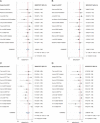The gap before real clinical application of imaging-based machine-learning and radiomic models for chemoradiation outcome prediction in esophageal cancer: a systematic review and meta-analysis
- PMID: 37463039
- PMCID: PMC10442126
- DOI: 10.1097/JS9.0000000000000441
The gap before real clinical application of imaging-based machine-learning and radiomic models for chemoradiation outcome prediction in esophageal cancer: a systematic review and meta-analysis
Abstract
Background: Due to tumoral heterogeneity and the lack of robust biomarkers, the prediction of chemoradiotherapy response and prognosis in patients with esophageal cancer (EC) is challenging. The goal of this study was to assess the study quality and clinical value of machine learning and radiomic-based quantitative imaging studies for predicting the outcomes of EC patients after chemoradiotherapy.
Materials and methods: PubMed, Embase, and Cochrane were searched for eligible articles. The methodological quality and risk of bias were evaluated using the Radiomics Quality Score (RQS), Image Biomarkers Standardization Initiative (IBSI) Guideline, and Transparent Reporting of a multivariable prediction model for Individual Prognosis or Diagnosis (TRIPOD) statement, as well as the modified Quality Assessment of Diagnostic Accuracy Studies (QUADAS-2) tool. A meta-analysis of the evidence focusing on predicting chemoradiotherapy response and outcome in EC patients was implemented.
Results: Forty-six studies were eligible for qualitative synthesis. The mean RQS score was 9.07, with an adherence rate of 42.52%. The adherence rates of the TRIPOD and IBSI were 61.70 and 43.17%, respectively. Ultimately, 24 studies were included in the meta-analysis, of which 16 studies had a pooled sensitivity, specificity, and area under the curve (AUC) of 0.83 (0.76-0.89), 0.83 (0.79-0.86), and 0.84 (0.81-0.87) in neoadjuvant chemoradiotherapy datasets, as well as 0.84 (0.75-0.93), 0.89 (0.83-0.93), and 0.93 (0.90-0.95) in definitive chemoradiotherapy datasets, respectively. Moreover, radiomics could distinguish patients from the low-risk and high-risk groups with different disease-free survival (DFS) (pooled hazard ratio: 3.43, 95% CI 2.39-4.92) and overall survival (pooled hazard ratio: 2.49, 95% CI 1.91-3.25). The results of subgroup and regression analyses showed that some of the heterogeneity was explained by the combination with clinical factors, sample size, and usage of the deep learning (DL) signature.
Conclusions: Noninvasive radiomics offers promising potential for optimizing treatment decision-making in EC patients. However, it is necessary to make scientific advancements in EC radiomics regarding reproducibility, clinical usefulness analysis, and open science categories. Improved model reporting of study objectives, blind assessment, and image processing steps are required to help promote real clinical applications of radiomics in EC research.
Copyright © 2023 The Author(s). Published by Wolters Kluwer Health, Inc.
Conflict of interest statement
The authors declare that they have no financial conflicts of interest with regard to the content of this report.
Figures





Similar articles
-
A systematic review of radiomics in chondrosarcoma: assessment of study quality and clinical value needs handy tools.Eur Radiol. 2023 Feb;33(2):1433-1444. doi: 10.1007/s00330-022-09060-3. Epub 2022 Aug 26. Eur Radiol. 2023. PMID: 36018355
-
Radiomics for predicting survival in patients with locally advanced rectal cancer: a systematic review and meta-analysis.Quant Imaging Med Surg. 2023 Dec 1;13(12):8395-8412. doi: 10.21037/qims-23-692. Epub 2023 Oct 26. Quant Imaging Med Surg. 2023. PMID: 38106286 Free PMC article.
-
Quality of science and reporting of radiomics in oncologic studies: room for improvement according to radiomics quality score and TRIPOD statement.Eur Radiol. 2020 Jan;30(1):523-536. doi: 10.1007/s00330-019-06360-z. Epub 2019 Jul 26. Eur Radiol. 2020. PMID: 31350588
-
Artificial intelligence with magnetic resonance imaging for prediction of pathological complete response to neoadjuvant chemoradiotherapy in rectal cancer: A systematic review and meta-analysis.Front Oncol. 2022 Oct 12;12:1026216. doi: 10.3389/fonc.2022.1026216. eCollection 2022. Front Oncol. 2022. PMID: 36313696 Free PMC article.
-
Quality of Radiomics Research on Brain Metastasis: A Roadmap to Promote Clinical Translation.Korean J Radiol. 2022 Jan;23(1):77-88. doi: 10.3348/kjr.2021.0421. Korean J Radiol. 2022. PMID: 34983096 Free PMC article.
Cited by
-
Prediction of malignant esophageal fistula in esophageal cancer using a radiomics-clinical nomogram.Eur J Med Res. 2024 Apr 4;29(1):217. doi: 10.1186/s40001-024-01746-2. Eur J Med Res. 2024. PMID: 38570887 Free PMC article.
-
Repeatability and prognostic value of radiomic features: a study in esophageal cancer and nasopharyngeal carcinoma.Insights Imaging. 2025 Aug 2;16(1):166. doi: 10.1186/s13244-025-02044-z. Insights Imaging. 2025. PMID: 40751118 Free PMC article.
-
Application of radiomics for preoperative prediction of lymph node metastasis in colorectal cancer: a systematic review and meta-analysis.Int J Surg. 2024 Jun 1;110(6):3795-3813. doi: 10.1097/JS9.0000000000001239. Int J Surg. 2024. PMID: 38935817 Free PMC article.
-
An anoikis-related lncRNA signature may predict the prognosis, immune infiltration, and drug sensitivity in esophageal cancer.Heliyon. 2024 May 14;10(10):e31202. doi: 10.1016/j.heliyon.2024.e31202. eCollection 2024 May 30. Heliyon. 2024. PMID: 38803953 Free PMC article.
-
Radiomics applications in the modern management of esophageal squamous cell carcinoma.Med Oncol. 2025 May 27;42(7):221. doi: 10.1007/s12032-025-02775-5. Med Oncol. 2025. PMID: 40425893 Review.
References
-
- Sung H, Ferlay J, Siegel RL, et al. . Global Cancer Statistics 2020: GLOBOCAN estimates of incidence and mortality worldwide for 36 cancers in 185 countries. CA Cancer J Clin 2021;71:209–249. - PubMed
-
- Siegel RL, Miller KD, Jemal A. Cancer statistics, 2020. CA Cancer J Clin 2020;70:7–30. - PubMed
-
- Lagergren J, Smyth E, Cunningham D, et al. . Oesophageal cancer. Lancet 2017;390:2383–2396. - PubMed
-
- Xi M, Yang Y, Zhang L, et al. . Multi-institutional analysis of recurrence and survival after neoadjuvant chemoradiotherapy of esophageal cancer: impact of histology on recurrence patterns and outcomes. Ann Surg 2019;269:663–670. - PubMed
Publication types
MeSH terms
Substances
LinkOut - more resources
Full Text Sources
Medical
Miscellaneous

